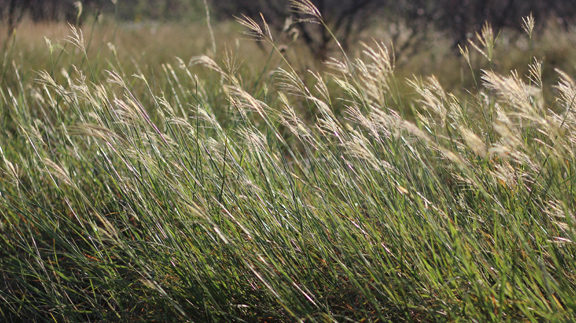HOME
Grazing North Texas – King Ranch Bluestem… Friend or Foe?

By Tony Dean
King Ranch bluestem is an aggressive introduced bunch grass that is now common across almost all North Texas grazing lands. Although it has never been planted on most ranches in North Texas, we would be hard pressed to find pastures that did not have at least a small population of King Ranch bluestem.
When taking an autumn drive across many Texas roads, the wavy grass with the maroon seed head seen on roadsides and in pastures is usually King Ranch bluestem.
King Ranch bluestem, or KR as it is often called, is a summer perennial and can reach heights up to 48 inches. The stems bend at each node and turn upward giving the plant a wide spreading appearance if left ungrazed and allowed to mature.
The seed heads contain two to ten or more spreading branches with each branch reaching one to three inches in length. King Ranch bluestem has the ability to produce a fast growing seed stalk following grazing or mowing, which probably helps it compete with other grasses.
King Ranch bluestem is wide spread over many other areas of the world. Although there are differences of opinion concerning how this species got to the United States, most references agree that it was brought to California from China in 1917. There is some mention that it was brought to the U.S. as early as 1894. It was introduced to Angleton, Texas, in 1924 and was widely available by 1949.
To read more pick up a copy of the December 2016 NTFR issue. Call 940-872-5922 to subscribe.
HOME
Preparing Spring Gardens

By Hannah Claxton | Editor
The North Texas area is located within USDA Hardiness zones seven and eight. The zones are categorized by predicted low temperatures for winter and timing of the first and last frosts.
Zone seven usually has winter low temps between 0 and 10 degrees F with the average date of the first frost falling between Oct. 29 and Nov. 15 and the average date of the last frost falling between March 22 and April 3.
Overall, these two zones have similar climates and growing conditions, making the options for timing and variety within a garden very similar.
In these zones, cool-season crops should go in the ground in March, meaning that soil preparation should start now.
To read more, pick up a copy of the January edition of North Texas Farm & Ranch magazine, available digitally and in print. To subscribe by mail, call 940-872-5922.

HOME
Equine Vaccinations

By Heather Lloyd
Vaccinations are a critical component of maintaining the health and well-being of horses, especially in environments where they are exposed to other animals, such as in the sport, show and performance arenas. Horses, like all animals, are susceptible to various infectious diseases that can spread quickly and cause serious harm.
A routine vaccination schedule helps prevent the spread of these diseases by preparing the horse’s immune system.
To read more, pick up a copy of the November edition of North Texas Farm & Ranch magazine, available digitally and in print. To subscribe by mail, call 940-872-5922.

HOME
Wichita Falls Area Cattlewomen

Having herds on a controlled breeding schedule means that we have a predictable calving schedule, and while it’s only over a couple of months, for us it does fall right after the start of the year. I lobby annually to call ours the “Winter calving season”, but I am outvoted and my husband still refers to it as Spring. Unlike producers in our Northern States, we don’t have to contend with brutally harsh winter weather, and on those rare times we do, thankfully it is not for extended periods. Regardless of whether you have a Spring or a Fall calving schedule, the health of a newborn calf begins with the mother’s health, and the mother’s health is largely dependent on the producer.
To read more, pick up a copy of the November edition of North Texas Farm & Ranch magazine, available digitally and in print. To subscribe by mail, call 940-872-5922.

-

 Country Lifestyles2 years ago
Country Lifestyles2 years agoScott & Stacey Schumacher: A Growth Mindset
-

 Country Lifestyles8 years ago
Country Lifestyles8 years agoStyle Your Profile – What your style cowboy hat says about you and new trends in 2017
-

 HOME8 years ago
HOME8 years agoGrazing North Texas – Wilman Lovegrass
-

 Outdoor10 years ago
Outdoor10 years agoButtercup or Primrose?
-

 Country Lifestyles5 years ago
Country Lifestyles5 years agoAmber Crawford, Breakaway Roper
-

 Country Lifestyles9 years ago
Country Lifestyles9 years agoJune 2016 Profile – The man behind the mic: Bob Tallman
-

 Equine1 year ago
Equine1 year agoThe Will to Win
-

 Country Lifestyles8 years ago
Country Lifestyles8 years agoDecember 2016 Profile, Rusty Riddle – The Riddle Way




